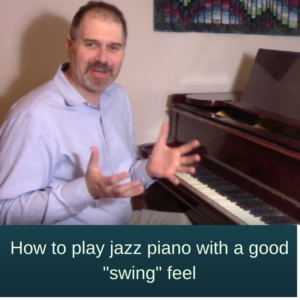
If you’re learning to play jazz piano but are struggling to play with a good “swing feel,” take heart that you’re not alone. In fact, this is one of the main challenges that any aspiring jazz pianist faces, and it can take a while to learn.
It wasn’t always this way, however. “Back in the day,” during the 1920s-1950s, the swing feel of jazz was very much related to a lot of pop music from the time. A budding jazz pianist would hear songs everywhere that had the swing beat. Broadway show tunes like Gershwin’s I Got Rhythm had a swing feel, even if there was no jazz improvisation in the original version. For a few decades, “swing” was a big part of American pop music, not just in jazz. Even non-musicians could easily sing their favorite songs with a good swing feel, since these songs were on the radio and in movies all the time. And for jazz players, this made it very easy to “swing” because they had been hearing and humming along to this music all their lives!
It’s different for us today, since most of the pop music around us is now based on a straight 8th-note concept. It’s not related to the jazz rhythm in the way that it once was. This is OK in itself, but it does mean that aspiring jazz musicians need to spend some time “learning to swing” in order to play the music with the right rhythmic concept.
So how do you do this? If you ask this question to 50 different jazz musicians, you’ll probably get 50 different answers, all valid. It can be more than a little confusing to sort it all out and decide what to practice!
My experience, both as a player and as a teacher, is that you should try everything you can think of and see which one “clicks” for you. The tricky thing is that you can’t predict which exercise/approach will be the magic one that leads you to a breakthrough, so it’s best to experiment with lots of different ways to practice the swing feel.
The great thing is that you’ll improve a lot by trying the various approaches, and then “violá!,” one of them will help you improve exponentially. But you’ll never know if you don’t try them all.
Participating in jam sessions, listening to recordings, and practicing a lot of jazz can all be really helpful in this regard. Probably what helped me personally the most was singing along with recorded solos until I completely internalized the rhythmic feel of the player(s). I remember that Herbie Hancock’s piano solo on There Is No Greater Love from the Miles Davis album Four & More was a breakthrough moment for me. But that was after lots of other practicing too.
Good luck and be sure to enjoy the process, even when it’s not sounding like you want it to sound. Everyone has gone through this, even someone as talented as the young Charlie Parker.
Here’s the Herbie Hancock solo that helped me a lot in terms of play with “swing feel.” I scat-sang along with each of Herbie’s piano phrases until I was totally in sync with him and had each one memorized and completely internalized. When I could easily sing the whole solo like this, I went back to the beginning and figured out the notes and wrote them down. Then I practiced the transcription on piano. Give it a try for yourself and have fun. It’ll be well worth the effort!!!
Miles Davis: There Is No Greater Love (Herbie Hancock’s piano solo begins at 7:21)
Learn the 5 Essential Left Hand Techniques with my free ebook: Left Hand Techniques for Jazz Piano
You’ll also get my weekly jazz newsletter with practice tips and inspiration

